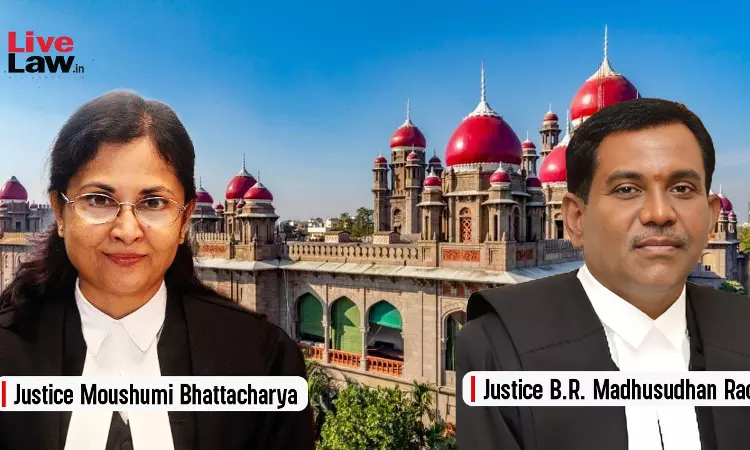- Home
- /
- High Courts
- /
- Telangana High Court
- /
- Non-Signatory Must Have Live &...
Non-Signatory Must Have Live & Proximate Connection To Arbitration Agreement For Being Pulled Into Proceedings U/S 9 Of A&C Act: Telangana HC
Mohd Talha Hasan
26 Aug 2025 10:46 AM IST
The Telangana High Court Division Bench comprising of Justice Moushumi Bhattacharya and Justice B.R. Madhusudhan Rao has observed that for being pulled into the proceedings u/s 9 of the Arbitration & Conciliation Act, a non-signatory must have a live and proximate connection to arbitration agreement. The bench observed that the law has pushed the boundaries to pull in non-signatories...
The Telangana High Court Division Bench comprising of Justice Moushumi Bhattacharya and Justice B.R. Madhusudhan Rao has observed that for being pulled into the proceedings u/s 9 of the Arbitration & Conciliation Act, a non-signatory must have a live and proximate connection to arbitration agreement.
The bench observed that the law has pushed the boundaries to pull in non-signatories to the arbitration agreement where the conduct of such parties reflects their intention to be bound by the arbitration agreement. A non-signatory cannot escape the obligations of an arbitration agreement by simply claiming they are not a party to it, if the facts show a close and direct connection with that agreement.
Factual Matrix:
Respondent No. 2 applied for allotment of a villa plot in 2008 under the Integrated Township Project developed by Emaar Hills Township Pvt. Ltd. (Respondent No. 3) and Emaar India (Respondent No. 1) at Manikonda, Hyderabad. Total consideration of the plot was Rs. 55,65,000/- of which ₹52,86,750/- (95%) was payable before the Agreement of Sale. As a lack of funds, the Respondent No. 2 executed a Memorandum of Understanding (MoU) with the Petitioner, dated 24.11.2008, for payment of Rs. 52,86,750/- (95%). in return for a 50:50 sharing of the built-up area upon construction. Pursuant to that, the Petitioner paid the said amount through two Banker's Cheques in favour of Respondent No. 3.
A registered Agreement of Sale was executed in favor of Respondent No. 2 in respect of the plot, acknowledging the receipt of the 95% consideration money paid by the Petitioner. Respondent No. 2 subsequently handed over the original documents of the Plot to the Petitioner, which were later required to be deposited in a case filed by the CBI against Respondent No. 1 & 3. On 20.06.2022, the Petitioner issued a legal notice to Respondent No. 2 restraining him from creating third-party rights over the plot.
On 12.09.2022, the Petitioner filed C.O.P. No. 89 of 2022 before the Commercial Court under Sec 9(1) (ii)(a-e) of the 1996 act, seeking interim injunction and directing the Respondent 1 & 3 to not execute a sale deed in favor of Respondent No. 2. Thereafter, Respondent No. 1 & 3 filed two I.As. in the C.O.P. for deletion of their names from the array of parties, which were allowed by the Commercial Court by orders dated 22.11.2023.
Submissions:
Submissions made by and on behalf of the Petitioner:
- The Respondent No. 1 & 3 allotted the plot and received the 95% consideration paid by the Petitioner and executed the sale agreement. Therefore, they could not be treated as strangers to the MoU.
- The Supreme Court in Cox and Kings v. SAP India Pvt. Ltd., 2024 and Ajay Madhusudan Patel v. Jyotrindra S.Patel, (2025) held that the non-signatories can be bound if their conduct shows connection.
- Further argued on maintainability that Sec 8 of the Commercial Court Act does not bar revisions under Article 227, and appeals under Sec 13(1A) were not the proper remedy since the orders were under Order I Rule 10 CPC.
Submissions made by and on behalf of the Respondent:
- Respondent No. 1 & 3 filed I.As under Order I Rule 10(2) CPC seeking for deletion of their names, arguing that they were not parties to the MoU dated 24.11.2008 and therefore not bound by the arbitration agreement.
Analysis of the Court:
In view of the arguments advanced, the bench first noted that a Civil Revision Petition under Article 227 is distinct from a revision under Sec. 115 CPC, and hence the bar under Sec8 of the Commercial Courts Act, 2015 does not apply.
Furthermore on issue of merits of the dispute, the bench noted that the Petitioner's COP. No. 89 of 2022 filed under Sec 9 of 1996 Act stemmed from the MoU dated 24.11.2008, containing the arbitration clause. The involvement of Respondent 1 & 3 in admitting and executing the Sale Agreement after receiving the 95% of total consideration from the Petitioner is enough to establish their close connection to the dispute. Relying on Cox and Kings and Ajay Madhusudan Patel, the Court emphasized that non-signatories cannot escape liability where their conduct shows a live and proximate connection with the arbitration agreement.
Further, Sec 9(1) of the 1996 Act and Order I Rule 10(2) CPC act as enabling provisions, allowing the Court to secure a fair and complete resolution of the dispute while preserving its subject matter until a final outcome is reached. The Court cannot allow key players to slip out midway and avoid scrutiny.
Lastly, the bench observed that the test of a non-signatory having live and proximate connection to the arbitration agreement so much so that the requirement of signing on the dotted line of a written agreement becomes irrelevant.
Case Name: K.Bala Vishnu Raja v. Emaar Hills Township Private Limited and Others
Case Number: C.R.P. Nos. 1014 and 1184 of 2024
Counsel for the Petitioner: Mr. T. Surya Satish
Counsel for the Respondent: Mr. Rajvinder Ahluwalia
Click Here To Read/Download Order



